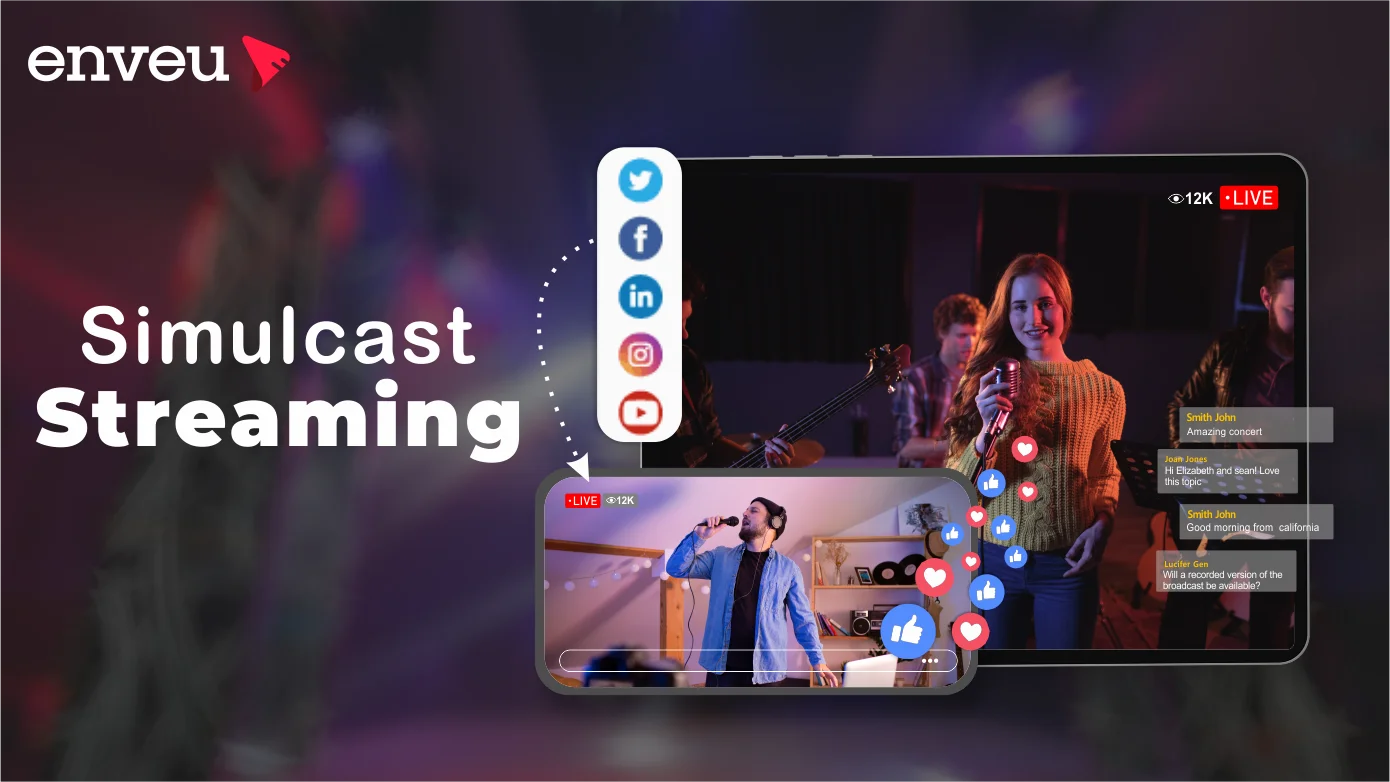In recent years, media and its delivery have changed significantly. A few decades ago, it was practically unimaginable that people could create their own media channels and broadcast to large audiences. Let’s say you want to start a broadcast, but your audience is on multiple platforms. Do you have to choose between TikTok and YouTube, Instagram and TikTok, etc.? no way! Simulcast streaming technology enables you to conduct simultaneous live broadcasts for multiple applications from a single platform. Let us explain what this means.
Table of Contents
What is simulcasting?
Simulcast is the synchronized transmission of programs or events across multiple services over the real-time messaging protocol (RTMP). A simulcast, for example, is the simultaneous broadcast of a football match on TV and radio.
The term “simulcast” originated in the US in 1948, when NBC and CBS began broadcasting multiple programs on both radio and television at the same time.
Today’s simulcast refers to content broadcast digitally through websites and social media networks. Virtual events, webinars, lectures, athletic events, or entertainment content can all be streamed to different platforms at the same time. Special repeaters have been installed for the simulcast system, which allows it to work continuously over long distances.
How does simulcasting work?

There are several options for broadcasting your live feed simultaneously. These usually involve the use of a video hosting manager and/or a dedicated simulcasting program or platform.
The technicalities of how simulcasting works vary depending on the approach used. Over-the-top (OTT) technology is commonly used to stream your videos over the internet.
The Benefits of Simulcast Architecture
- In comparison to previous VC systems, the numerous degrees of quality allow for some flexibility.
- This prevents the server from having to process the video.
- Simulcasting also helps to cut costs.
- Media outlets can split the expense of generating material by streaming the same content over many channels. This is especially useful for smaller outlets, as it allows them to produce more material without increasing their budget. Simulcasting also saves time.
- Instead of producing separate copies of the same content for different channels, media outlets can simply simulcast the same information over several channels. This helps to save time and resources, which can then be used to create additional content.
Simulcast vs. Multicast: Are They the Same?
Simply put, both of these techniques broadcast the same signal from different locations at the same time, however simulcast uses the same frequency while multicast uses different frequencies. Let’s compare both are them.

Benefits of Simulcasting
The capacity to send numerous copies of the same content at the same time is the primary advantage of simulcasting. This increases productivity and allows content creators to reach the broadest audience possible.
- Simulcasting allows you to share media across all of your channels at once, saving you time and money on developing unique content for each channel with an audience. Different platforms have different media content requirements. And, in order to transmit signals that fit those criteria, you’ll either need alternative material or a mechanism to repackage your content to meet the specifications of each platform. Take a look at social media: to livestream, most networks require a proprietary real-time messaging protocol (RTMP).
- Increase your potential viewership by streaming on many platforms at the same time. You can interact with your audience on each site, and people may watch your live video on whichever platform they like.
- Stream to several channels on a single platform: If you want to broadcast to more than one YouTube channel, Facebook page, or Facebook group, simulcasting allows you to do so without any extra effort.
- Reduce costs and save time: You save time and money on producing content for each platform by streaming your videos to each one at the same time.
Conclusion
The purpose of simulcasting or multi-streaming is always the same: to reach a larger audience. Some methods of simulcasting do this by delivering content to audiences in a more appropriate format, whereas others simply allow more people to access your program. In any case, it’s a tradition that modern-day streamers are carrying on. Although tools like Restream make multi streaming easier, you should still take the time to master the basics. Then, you can employ simulcasting (or multi streaming) to boost the reach of your live streaming.
Frequently Asked Questions (FAQ)
Ans: Simulcast uses the same frequency to broadcast the same signal, while multicast uses different frequencies. Simulcast requires signal control and is effective in terms of frequency consumption, whereas multicast does not have signal control requirements.
Ans: Simulcasting allows you to increase viewership by streaming on multiple platforms simultaneously, interact with diverse audiences, and save time and costs associated with creating unique content for each platform.
Ans: Yes, simulcasting enables you to broadcast on various social media platforms simultaneously, such as YouTube, Facebook, and others, expanding your reach without additional effort.
Ans: Absolutely! Simulcasting is ideal for virtual events, webinars, lectures, and other online gatherings, allowing you to engage with a wider audience across different platforms.
Ans: Simulcasting enhances content distribution by sharing the same media across multiple channels simultaneously, increasing visibility, and enabling content creators to tailor their messages to diverse platform requirements.
